Wool Care.
Care and Use-please scroll down for the various HB products.


Merino Jersey and Merino-Tencel-Jersey
For the longest life handwashing your clothing using wool wash (we recommend Unicorn Fibre Wash) and laying flat to dry is prefered. Clothes can also be washed at 30C in the washing machine but please be aware this can cause premature wearing depending on the washer.
Washing machines also tend to have residual soaps from the normal wash routine and these can be very damaging to wool. Due to the residual soap issues we STRONGLY advise hand washing. One wrong wash can ruin the wool fibers and over time they are likely to become brittle, thinner, and prone to holes.
Colours do tend to bleed the first few washes so please wash with like colours.
Periodic lano-ing of jersey items is recommended to condition the wool especially for items that deal with rubbing movement, trousers/shorts/capris. Lano is especially important after a deep clean.
Please be aware that unicorn beyond clean can be used for a keep cleaning but for daily wash we ighly recommend unicorn fibre wash. Also note that soaking in soap, such as beyond clean, for longer than 15 minutes can cause discolouration issues.
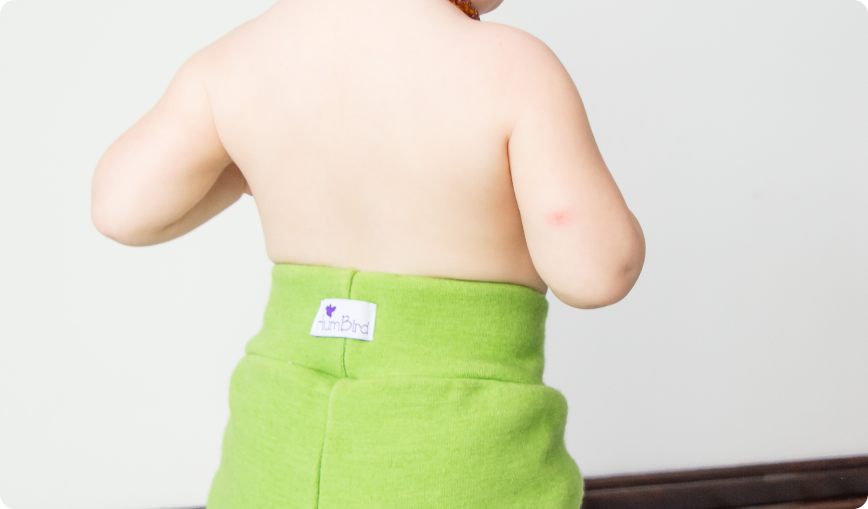
Washing Interlock Wool And How To Lanolize
This guide is written specifically for HB interlock wool.
WASH YOUR WOOL! You
must get all the dirt and urine out of the wool before lanolizing. Make
sure your wool is CLEAN! Washing and lanolizing are two different
steps.
Do not skip thoroughly washing your wool because it
will cause damage over time. Urine salts and any soiling will become
trapped on the wool fiber and sealed in by lanolin. This will cause
unnecessary stress on the wool fibers by drying them out and making the
fibers less stretchy and stiff over time, which can also lead to seam
stretching, thinning, and color distortion. Urine is also acidic and
when sealed into the wool can eat away at it.
Please read this blog post BEFORE buying and trying wool washes.
https://humbird.eu/blogs/news/wavy-seams-a-discussion
Hand washing:
Fill your washbasin with tepid water between 86 and 95F (35C). For very dirty wool choose a warmer temperature in this range. If you do not have access to a thermometer use a temperature that feels like warm bath water.
Add Wool Wash while filling the basin. We recommend Unicorn Beyond Clean (unscented version) or Unicorn Power Scour (scented) or Unicorn Fibre Wash for cleaning when the woolies are not that dirty and do not need a deep clean or lano-removal. Whatever products you choose, follow the manufacturer’s instructions. When using Unicorn add about ½ teaspoon to your water basin and mix. This amount may vary according to your specific situation. Less is more -- Unicorn is VERY concentrated. Start with less and adjust as needed (more facts about washing wool below). Per Unicorn’s recommendation, soak for up to 15 minutes. Periodically while soaking, gently squeeze the item while submerged in the water to make sure water solution has penetrated throughout all the fibers.
Rinse your wool until the water is clear. Either rinse under the faucet with similar temperature water as what you soaked in, or empty your bath water, refill with clean water that is a similar temperature and let your wool soak again. Remember to gently squeeze your wool again while rinsing to ensure the fibers are being rinsed out. In making sure that the wool is as clean as possible, you will also want to be sure that the wool wash is completely rinsed before lanolizing. Rinse until the water is clear.
*If stained, heavily soiled, or if your wash water is very dirty, repeat the above steps.
Lanolizing:
Make lano milk. Take a cup of very hot water, add lanolin (Rule of thumb
is one teaspoon per baby wool item. Please adjust according to size.
For example, adult leggings need at least a tablespoon) and your
emulsifying agent (e-cube, dish soap, baby soap), let dissolve and stir.
The resulting mixture will look nice and milky. If your mixture forms a
top layer that looks oily, you may need to add more emulsifier.
Slowly stir in your lano milk to a warm bath of clean water. Your lano
milk should be about the same temperature as your bath water. You can
add a few ice cubes to your lano to gently cool it down prior to mixing
with your bath water.
- If the lano mixture is not creating a beautiful white milk then you may need to add additional emulsifier.
- If you step away from the lano milk and it cools too much and separates adding hot water will melt it all back together.
- If the temperature of your lano milk and bath water are too different that may “shock” the mixture and solidify some of the lanolin on the surface of the water. Adding very hot water and/or soap MAY fix this situation.
Troubleshooting:
Turn your damp wool inside out and add it to the lano bath.
Soak for 20 -30 minutes. Take out the wool and gently squish out the water (never wring out wool!). You can then give them a quick spin in your washing machine (on wool cycle or gentle cycle only) to remove excess water and hang or lay flat to dry. Another method is laying your wool on a towel and rolling it up while pressing it as you go to press out the water, then laying flat to dry. You may speed up the drying process by placing a box fan near the wool. It is not recommended to lay your wool out in direct sunlight.
Wool care does not need to be complicated or confusing. Please reach out to one of the admins or post in Facebook group if you need any help or clarification.
Process of cleaning
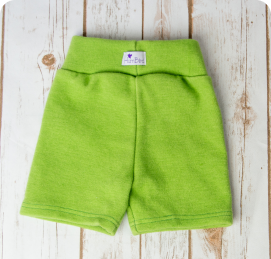
STEP 1
Clean wool
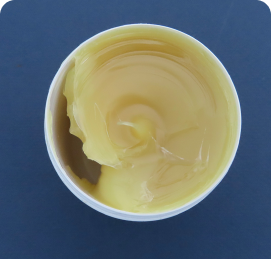
STEP 2
Basin of clean, warm water & Lanolin & emulsifier
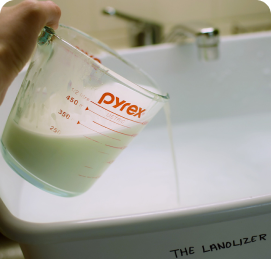
STEP 3
Place Lanolin & emulsifier in hot water.

STEP 4
Allow Lano & emulsifier to melt into the hot water.
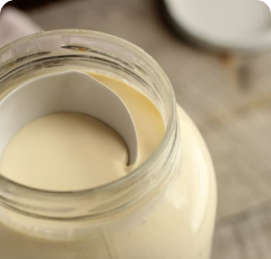
STEP 5
Stir or shake until Lano milk is formed. It looks white & creamy just like cow’s milk.
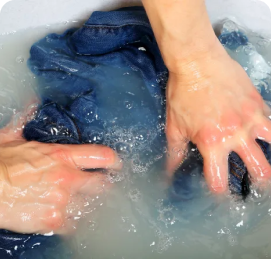
STEP 6
Stir lano milk into the basin of water, then add your inside-out woolies !
Machine Washing:
Machine washing interlock wool requires the wool or delicate cycle on your washing machine. Unicorn recommends warm water and 1 ounce of Unicorn for normal loads. Use less for lighter soil levels or smaller loads. Again, less is more!
Recommend Products
Used to condition the wool and keep it looking its best.
Use only wool safe soaps on all your HumBird wool. "Bio" washes may contain enzymes that can eat away at the wool fibers.
Other small shops that we like. Please note that we are not associated with these shops. If you feel we should not have a shop on our fun stuff page please contact us.
No one likes stains so let us help get yours out. For tough spots on interlock, put some unicorn beyond clean directly on the stain (color test in an inconspicuous place first, but we've never had an issue as long as I work it in with warm water) and use a soft toothbrush with warm water to gently scrub the stain. If it’s really bad, I might have to do this a few times with soaks in between. I can’t think of a time it hasn’t been successful, but the key is *don’t let it dry.*
HumBird wants your wool to last!
That is why we do not recommend using mainstream laundry detergents. Common household laundry detergents are not appropriate for wool especially if it contains enzymes. Enzymes are in laundry detergents to eat protein stains. Wool is made of protein. This can cause accelerated wear by breaking down the weakened fibers.
We also no longer recommend lanolin rich wool washes. The biggest thing to remember is that washing and lanolizing are two different steps. Lano-rich wool washes contain lanolin and can impede proper washing. It is our (and other wool makers’) opinion that the lanolin in it is enough to hold on to some of the soil on the wool but not enough of it to be useful towards moisture protection for diaper cover use.
Tips and Tricks from the Admin
- Don't be afraid to rewash. If your wash water is really dirty, give them additional baths to get all the gunk out. This is especially true if you have a piece of wool that may have several layers of lano and soil. Don’t fret! You can get them clean!
- Always lanolize inside out. Sometimes you can get a lano spot, this will not hurt your wool and will quickly wear off after a few wears.
- Washing in a white or light colored basin will really allow you to see if the wool is getting clean. It can be difficult to see if your water is still dirty or if there is still wool wash in a dark colored basin, like a metal sink. A white plastic dish basin works great.
- A baby bath tub is also good for washing. It's big enough to lay the wool flat in the water, allow agitation, but also small enough to maintain control over the water and soap amounts that are needed.
- To temper the lano milk so there is less risk of separation, add some of the water from the basin to the lano milk and stir before pouring into the basin and stirring to mix.
Flats And Inserts
- Dump or rinse off any solids. Rinse warm. Machine wash warm with recommended detergent amount (will vary, depending on detergent and load size). Then rinse cold and either line dry or tumble dry low.
- Hot washing and/or drying over extended periods of time wear out fabrics.
- Your flats and inserts will need up to 10 washes for full absorption. We recommend one wash before using and then just use as normal knowing it is not full prepped yet.
© 2021 HumBird Designed by Your Digital Media

